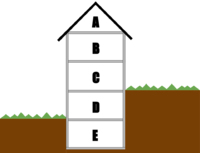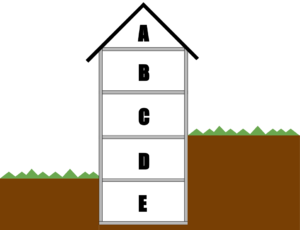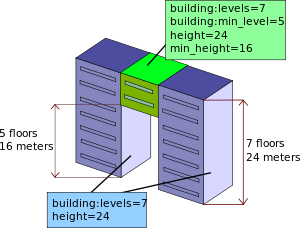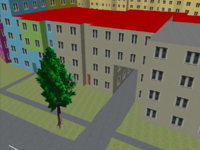Key:building:levels
| Description |
|---|
| The number of above ground levels in the building facades. |
| Group: buildings |
| Used on these elements |
| Requires |
|
| Useful combination |
| See also |
| Status: de facto |
| Tools for this tag |
|
The building:levels tag is used for marking the actual number (see value section) of above-ground levels (= floors = storeys) of a building (building=*) or part of a building (building:part=*). The underground levels and the roof do not count as levels here. However, levels that are part-way underground do count (see example below). For the purposes of this tag, "ground level" is defined to be the lowest entrance to a building.
It can be useful to also add height=*, especially if the height per level is different for each building part. Keep in mind that height=* includes the roof, while building:levels does not.
Example
- B + C + D counts as building:levels=3
- E counts as building:levels:underground=1
- A counts as roof:levels=1
Buildings with parts that don't start at ground level
If a building part does not start at the ground level, building:levels=* should include the number of skipped levels below the building part (i.e the number of levels that would exist if the space between the ground and the bottom of the building part were filled with levels of the typical height for this building). The key building:min_level=* should be used to describe the number of skipped levels in this building part.
See Simple 3D Buildings for more information.
Values
Values should be a positive integer number. Fractional values (like 1.5) are not valid (what is the meaning of a 0.5 floor?) and probably means that the mapper diverted the tags *:levels to express a height instead of using the appropriate tags. The usual dimension is a height of 3 meters for each floor (default floor height used for 3D renderings when the height tags are not specified). Use height and roof:height if a building has unusual dimensions. For example, use building:levels=1 and height=4.5 if the building has one 4.5 m high floor instead of building:levels=1.5.
The height of buildings (in meters) is usually difficult to determine if there is no right data, e.g. from a cadastre. But the default value of 3 meters for one floor is probably a good approximation of the actual height, if you don't know it, for most of the buildings. So you don't need to add the height tags for a normal 4-storey building. If floors are clearly larger or smaller than the default value (for example a sport hall 6 meters high, or a small shelter 2 meters high, or a 4-storey retail building higher than a 5-storey residential building), use the tags height or/and roof:height.
For a better understanding, see Simple_3D_Buildings#Usage_of_height,_roof:height,_building:levels,_roof:levels.
The number of levels is a relative value – you know only how many levels a building has and when drawing building:parts, you give their relative number of levels in relation to the whole building.
Rendering examples
OSMBuildings and OSM2World take this tag into account and render floors as windows.
See also
- level=* – Floor number of a feature
- building:min_level=* – For describing number of values under the bottom of the building, "filling" space between ground level and bottom level of building or part of building
- height=* – Physical attribute of an object (building, tree, tower...). Height is the measurement of vertical distance. It indicates how "tall" something is
- min_height=* – Height of location of bottom part of a building, part of building or another object
- roof:levels=* – For stating the number of levels in the roof of a building
- building:levels:underground=* – To mark number of levels under ground level
- Simple 3D Buildings
- Sophox query for average building heights by floor count
- Simple Indoor Tagging



